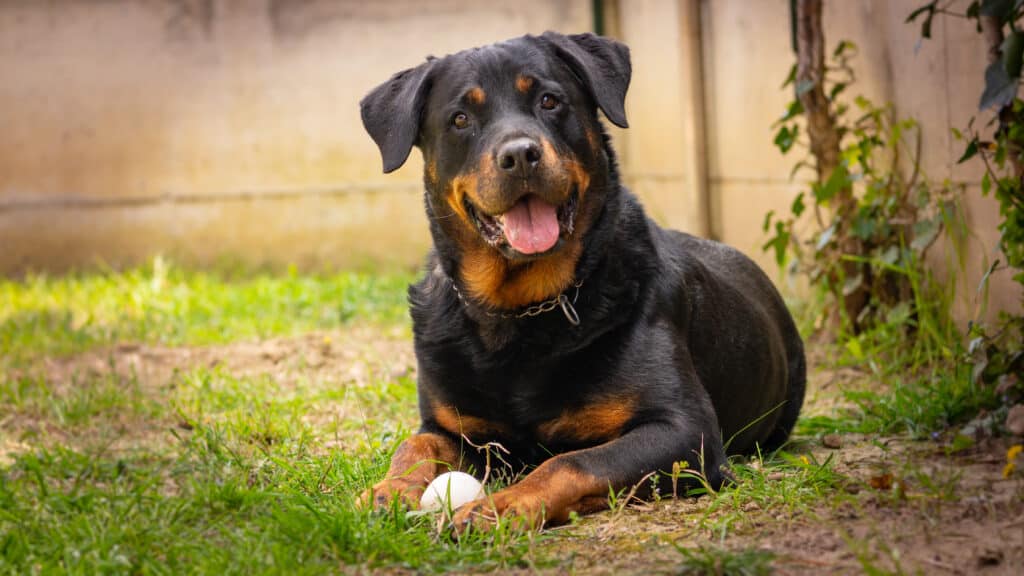Akita vs Rottweiler: What Are The Differences?
When it comes to the Akita vs Rottweiler, both are excellent guard dogs who love having a job to do.
The Akita is a strong, independent, willful dog with a dignified bearing and courageous personality. This can often lead to territorial behavior and distrust or indifference of strangers. It can also act aggressively toward other dogs, particularly those of the same sex.
The Rottweiler is famous for having a loyal, affectionate, sensitive and protective personality. Due to its calm and quiet temperament it is a popular choice for families, including those with children.
Follow along below as we dig into all of these dogs’ characteristics and learn what makes each guarding breed so special.
Comparing Akita vs Rottweiler

A-Z-Animals.com
| Akita | Rottweiler | |
|---|---|---|
| Size | 24-28 inches, 70-130 pounds | 22-27 inches, 77-132 pounds |
| Appearance | Upright ears, curled tail | Floppy ears, tail is usually docked |
| Fur | Medium-length double coat can be black, brown brindle, fawn, red, white, or silver. May have a black overlay, mask, or markings. | Short, smooth, black coat with tan, mahogany, or rust markings. |
| Lifespan | 10-15 years | 8-10 years |
| Temperament | Not generally good with other dogs and might be wary of strangers. | Extremely affectionate, playful, and adaptable. May be stand-offish with other dogs and new people. |
| Trainability | Intermediate | Easy |
| Grooming Needs | Moderate | Low |
| Drooling Level | Low | Moderate |
| Energy Level | Moderate | Moderate but needs plenty of mental stimulation |
| Barking Level | Low | Very low |
Key Differences Between Akita and Rottweiler
The largest difference between Akitas and Rottweilers is trainability. While Rotties can be slightly stubborn, they have nothing on Akitas, who can be a challenge to train.
Other key differences include size, appearance, lifespan, temperament, grooming, drooling level, energy level, and barking level.
Let’s explore these differences below!
Akita vs Rottweiler: Size
Akitas are slightly taller than Rottweilers, while Rotties tend to weigh more. Rottweilers stand 22-27 inches tall and weigh 77-132 pounds.
Meanwhile, Akitas are 24-28 inches tall and weigh 70-130 pounds.
When it comes to the size of your dog, things to consider include guarding abilities and cost. However, there isn’t enough size difference between these breeds to make an impact on your wallet. Both will also make imposing guard dogs!
Akita vs Rottweiler: Fur

Kseniia Kolesnikova/Shutterstock.com
One of the things you’ll notice first about an Akita is its medium-length double coat! These dogs are incredibly fluffy and adorable.
Akita fur comes in a variety of colors as well, including:
- Black
- Brown brindle
- Fawn
- Red
- White
- Silver
Akitas may have a black overlay on their coat or any of the following markings:
- White mask with white markings
- Black mask with white markings
- Black and white mask with white markings
- Pinto, black, and white mask
- Pinto and black mask
Rottweilers have a short, sleek coat. It can only be black in color according to the breed standard, though Rotties do have rust, mahogany, or tan markings as well.
Akita vs Rottweiler: Appearance
Alongside their differences in size and coat, these breeds also have a few other stand-out characteristics. Akitas have fluffy tails that naturally curl onto their backs and pointed ears, while Rotties have floppy ears.
Rottweilers, unfortunately, typically have their tail docked when young. This amputation is cosmetic and puts the dog through needless pain. It can also impact their communication with other dogs.
Many people choose to dock their Rottweiler’s tail due to the American Kennel Club’s breed standards.
Akita vs Rottweiler: Lifespan

iStock.com/Eduard_Mikrykov
Akitas live quite a bit longer than Rottweilers. While an Akita can live up to 15 years, Rotties live just 8-10 years on average.
Of course, these are just averages, and every dog is different. Your dog’s health and care will play roles in how long they live. Though there are no guarantees, things that keep a dog healthy include regular check-ups at the veterinarian, a healthy diet, and daily exercise.
Akita vs Rottweiler: Temperament
Akitas don’t tend to play well with other dogs. The AKC recommends intense caution during introductions and warns that Akitas are often dog aggressive.
While both breeds were bred to guard, the Akita may be on higher alert and more likely to show aggression to strangers. Rottweilers can also be wary of new people, but typically to a lesser extent.
Both dogs should be well-socialized, well-trained, and restrained or confined when needed. For instance, you’ll want a backyard with a tall fence to prevent the dogs from escaping. They’re likely to defend what they see as theirs, such as the yard, house, or family.
Rotties are more affectionate with family, more adaptable, and more playful. They can become clingy to their families, sometimes resulting in separation anxiety. It’s important that they know how to be alone for short periods without stress.
It’s also vital to ensure someone is home with them most of the day. Rottweilers do best with families rather than single people.
Akita vs Rottweiler: Trainability

nicolas.fontana/Shutterstock.com
Rottweilers can have a stubborn streak, but most are easy to train. They’re eager to please their people, which works in your favor!
Akitas, on the other hand, can be more headstrong. Training might present challenges and take more patience than training other breeds.
It’s important to socialize and train both dogs throughout their life so that they become confident and well-balanced adult dogs.
Always keep training sessions short and positive with any dog. Make sure you’re bringing a high-value reward to the table, whether it’s your dog’s favorite toy or a snack they love!
With guarding breeds, who can already be prone to aggression, it’s vital not to use harsh training methods or to try to dominate your dog. This can have catastrophic results.
Akita vs Rottweiler: Grooming Needs
Both dogs should be brushed once weekly with the exception of their shedding seasons. During shedding season, you should groom your dog more often to keep their coat healthy and your floors clean.
While Rottweilers shed moderately and a bit more severely during shedding season, Akitas have huge shedding periods where they blow out their entire coats! This means a lot more maintenance to keep them and your home clean. Expect plenty of combing and vacuuming.
The shedding season for both dogs typically occurs in the spring and the fall.
Akita vs Rottweiler: Drooling Level
Akitas seldom drool, and you likely won’t notice much of it. Rotties drool moderately. This means you might see the drool on the floor around the water bowl or your leg when they’re begging for a treat!
However, you’re unlikely to need to wipe their face or find too many random drool puddles around your home.
Akita vs Rottweiler: Energy Level

iStock.com/Meagan Jenkins
Both of these breeds require moderate exercise. Rotties will enjoy running and playing more than Akitas, making them perfect dogs for more active individuals.
Akitas do well with one long walk or jog daily. They can actually be couch potatoes in some situations and are highly adaptable when it comes to exercise. This isn’t an excuse not to walk them, however! Daily exercise is still vital to their health and wellbeing.
Rottweilers also need a lot more mental stimulation than Akitas, but both dogs can benefit from enrichment activities like puzzle toys, games, and homemade activities.
Akita vs Rottweiler: Barking Level
Rottweilers bark to alert, and that’s them doing their job as guard dogs! They’re unlikely to bark for a prolonged amount of time or develop excessive barking behavior.
Akitas bark slightly more than Rotties but are still likely to stop once they’ve alerted you to what they feel is important. (Whether you feel it’s important is another thing!)
If you find your dog barking too much, make sure they’re getting all of the exercise and mental stimulation they need each day. Then, work on training your dog on what they should and shouldn’t “guard” you from. For instance, you might not want them to bark each time the mail is delivered.
A “quiet” command is vital for large dogs with big voices!
Ready to discover the top 10 cutest dog breeds in the entire world?
How about the fastest dogs, the largest dogs and those that are — quite frankly — just the kindest dogs on the planet? Each day, AZ Animals sends out lists just like this to our thousands of email subscribers. And the best part? It’s FREE. Join today by entering your email below.
More from A-Z Animals
When it comes to the Akita vs Rottweiler, both are excellent guard dogs who love having a job to do.
The Akita is a strong, independent, willful dog with a dignified bearing and courageous personality. This can often lead to territorial behavior and distrust or indifference of strangers. It can also act aggressively toward other dogs, particularly those of the same sex.
The Rottweiler is famous for having a loyal, affectionate, sensitive and protective personality. Due to its calm and quiet temperament it is a popular choice for families, including those with children.
Follow along below as we dig into all of these dogs’ characteristics and learn what makes each guarding breed so special.
Comparing Akita vs Rottweiler

A-Z-Animals.com
| Akita | Rottweiler | |
|---|---|---|
| Size | 24-28 inches, 70-130 pounds | 22-27 inches, 77-132 pounds |
| Appearance | Upright ears, curled tail | Floppy ears, tail is usually docked |
| Fur | Medium-length double coat can be black, brown brindle, fawn, red, white, or silver. May have a black overlay, mask, or markings. | Short, smooth, black coat with tan, mahogany, or rust markings. |
| Lifespan | 10-15 years | 8-10 years |
| Temperament | Not generally good with other dogs and might be wary of strangers. | Extremely affectionate, playful, and adaptable. May be stand-offish with other dogs and new people. |
| Trainability | Intermediate | Easy |
| Grooming Needs | Moderate | Low |
| Drooling Level | Low | Moderate |
| Energy Level | Moderate | Moderate but needs plenty of mental stimulation |
| Barking Level | Low | Very low |
Key Differences Between Akita and Rottweiler
The largest difference between Akitas and Rottweilers is trainability. While Rotties can be slightly stubborn, they have nothing on Akitas, who can be a challenge to train.
Other key differences include size, appearance, lifespan, temperament, grooming, drooling level, energy level, and barking level.
Let’s explore these differences below!
Akita vs Rottweiler: Size
Akitas are slightly taller than Rottweilers, while Rotties tend to weigh more. Rottweilers stand 22-27 inches tall and weigh 77-132 pounds.
Meanwhile, Akitas are 24-28 inches tall and weigh 70-130 pounds.
When it comes to the size of your dog, things to consider include guarding abilities and cost. However, there isn’t enough size difference between these breeds to make an impact on your wallet. Both will also make imposing guard dogs!
Akita vs Rottweiler: Fur

Kseniia Kolesnikova/Shutterstock.com
One of the things you’ll notice first about an Akita is its medium-length double coat! These dogs are incredibly fluffy and adorable.
Akita fur comes in a variety of colors as well, including:
- Black
- Brown brindle
- Fawn
- Red
- White
- Silver
Akitas may have a black overlay on their coat or any of the following markings:
- White mask with white markings
- Black mask with white markings
- Black and white mask with white markings
- Pinto, black, and white mask
- Pinto and black mask
Rottweilers have a short, sleek coat. It can only be black in color according to the breed standard, though Rotties do have rust, mahogany, or tan markings as well.
Akita vs Rottweiler: Appearance
Alongside their differences in size and coat, these breeds also have a few other stand-out characteristics. Akitas have fluffy tails that naturally curl onto their backs and pointed ears, while Rotties have floppy ears.
Rottweilers, unfortunately, typically have their tail docked when young. This amputation is cosmetic and puts the dog through needless pain. It can also impact their communication with other dogs.
Many people choose to dock their Rottweiler’s tail due to the American Kennel Club’s breed standards.
Akita vs Rottweiler: Lifespan

iStock.com/Eduard_Mikrykov
Akitas live quite a bit longer than Rottweilers. While an Akita can live up to 15 years, Rotties live just 8-10 years on average.
Of course, these are just averages, and every dog is different. Your dog’s health and care will play roles in how long they live. Though there are no guarantees, things that keep a dog healthy include regular check-ups at the veterinarian, a healthy diet, and daily exercise.
Akita vs Rottweiler: Temperament
Akitas don’t tend to play well with other dogs. The AKC recommends intense caution during introductions and warns that Akitas are often dog aggressive.
While both breeds were bred to guard, the Akita may be on higher alert and more likely to show aggression to strangers. Rottweilers can also be wary of new people, but typically to a lesser extent.
Both dogs should be well-socialized, well-trained, and restrained or confined when needed. For instance, you’ll want a backyard with a tall fence to prevent the dogs from escaping. They’re likely to defend what they see as theirs, such as the yard, house, or family.
Rotties are more affectionate with family, more adaptable, and more playful. They can become clingy to their families, sometimes resulting in separation anxiety. It’s important that they know how to be alone for short periods without stress.
It’s also vital to ensure someone is home with them most of the day. Rottweilers do best with families rather than single people.
Akita vs Rottweiler: Trainability

nicolas.fontana/Shutterstock.com
Rottweilers can have a stubborn streak, but most are easy to train. They’re eager to please their people, which works in your favor!
Akitas, on the other hand, can be more headstrong. Training might present challenges and take more patience than training other breeds.
It’s important to socialize and train both dogs throughout their life so that they become confident and well-balanced adult dogs.
Always keep training sessions short and positive with any dog. Make sure you’re bringing a high-value reward to the table, whether it’s your dog’s favorite toy or a snack they love!
With guarding breeds, who can already be prone to aggression, it’s vital not to use harsh training methods or to try to dominate your dog. This can have catastrophic results.
Akita vs Rottweiler: Grooming Needs
Both dogs should be brushed once weekly with the exception of their shedding seasons. During shedding season, you should groom your dog more often to keep their coat healthy and your floors clean.
While Rottweilers shed moderately and a bit more severely during shedding season, Akitas have huge shedding periods where they blow out their entire coats! This means a lot more maintenance to keep them and your home clean. Expect plenty of combing and vacuuming.
The shedding season for both dogs typically occurs in the spring and the fall.
Akita vs Rottweiler: Drooling Level
Akitas seldom drool, and you likely won’t notice much of it. Rotties drool moderately. This means you might see the drool on the floor around the water bowl or your leg when they’re begging for a treat!
However, you’re unlikely to need to wipe their face or find too many random drool puddles around your home.
Akita vs Rottweiler: Energy Level

iStock.com/Meagan Jenkins
Both of these breeds require moderate exercise. Rotties will enjoy running and playing more than Akitas, making them perfect dogs for more active individuals.
Akitas do well with one long walk or jog daily. They can actually be couch potatoes in some situations and are highly adaptable when it comes to exercise. This isn’t an excuse not to walk them, however! Daily exercise is still vital to their health and wellbeing.
Rottweilers also need a lot more mental stimulation than Akitas, but both dogs can benefit from enrichment activities like puzzle toys, games, and homemade activities.
Akita vs Rottweiler: Barking Level
Rottweilers bark to alert, and that’s them doing their job as guard dogs! They’re unlikely to bark for a prolonged amount of time or develop excessive barking behavior.
Akitas bark slightly more than Rotties but are still likely to stop once they’ve alerted you to what they feel is important. (Whether you feel it’s important is another thing!)
If you find your dog barking too much, make sure they’re getting all of the exercise and mental stimulation they need each day. Then, work on training your dog on what they should and shouldn’t “guard” you from. For instance, you might not want them to bark each time the mail is delivered.
A “quiet” command is vital for large dogs with big voices!
Ready to discover the top 10 cutest dog breeds in the entire world?
How about the fastest dogs, the largest dogs and those that are — quite frankly — just the kindest dogs on the planet? Each day, AZ Animals sends out lists just like this to our thousands of email subscribers. And the best part? It’s FREE. Join today by entering your email below.









